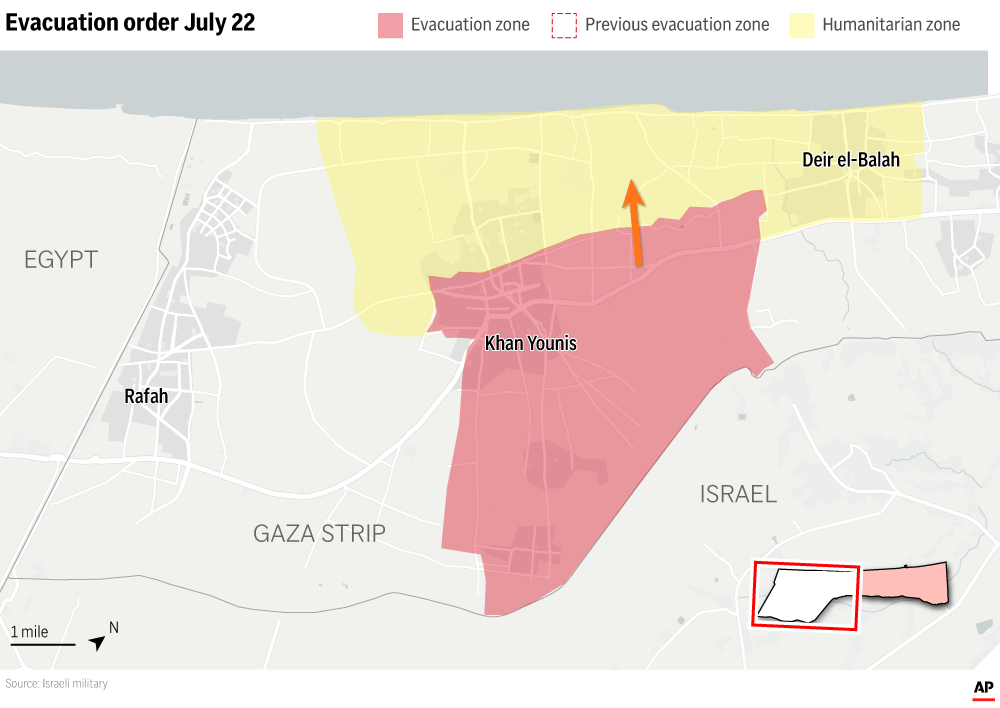DEIR AL-BALAH, Gaza Strip (AP) — Bodies piled up in southern Gaza as young women screamed and elbowed each other, desperately trying to reach the front of the food queue. The men dished out rice and chicken as fast as they could, plates of nutritious food falling to the floor in a flurry.
Nearby, boys waited to fill plastic containers with water, standing for hours amid tents packed so tightly they were almost touching.
Hunger and desperation were palpable Friday in a tent camp along the coast of Deir al-Balah after a month of successive evacuation orders that squeezed thousands of Palestinians into what the Israeli military calls a “humanitarian zone.”
Consists of zone A long meeting The Palestinians sought refuge from the bombardment, but the situation worsened day by day, with waves of evacuees arriving and food and water becoming scarce. Over the past month, the Israeli military has issued evacuation orders from southern Gaza Unprecedented speed.
According to the UN, 90% of Gaza’s 2.1 million people were displaced during the war and at least 84% of Gaza now falls within the evacuation zone.
According to an Associated Press count, 13 evacuation orders have been issued since July 22, significantly reducing the size of the humanitarian zone declared by Israel at the start of the war and forcing more Palestinians into it than before. The increased crowd of evacuees can be seen in satellite images.

Gaza residents were ordered to evacuate from July 22.
“The food from the charity is enough for the people in our camp,” said Muhammad Al-Qaid, who moved from Gaza City and now lives along the coast. “Where are the recently displaced people getting food? Where to supply them?”
Adam Hijazi, another displaced Palestinian, said: “I began to think that if there was no food, I would drink seawater to survive. I’m serious. I drink water and salt.
The military says the evacuations are necessary because Hamas has fired rockets from inside the humanitarian zone. In posts on X, the army’s Arabic-language spokesman, Avichay Adraee, advised Palestinians to leave immediately, saying the army would soon act “with force” against Hamas militants in the area.
Yasser Felfel, the first displaced from northern Gaza, saw his camp swell with waves of evacuees.
“There were 32 people in my tent. Now there are almost 50 people I don’t know,” he said. “There is a lot of food left over from a week ago. We had breakfast, lunch and dinner. Today, due to the number of people who came here, lunch itself was not enough.
In August alone, evacuation orders were issued roughly every two days, displacing nearly 250,000 people, according to the UN.
“Many here have moved more than 10 times. They are tired and broken,” said Georgios Petropoulos, head of the UN Office for Humanitarian Affairs in Gaza.
A pair of satellite photos taken last month show the impact of the orders. Images obtained from PlanetLabs and reviewed by the AP show tent camps along the coast were densely packed from July 19 to August 19.
On August 19, tents covered almost all the sand dunes and were pitched close to the sea.
Even Palestinians living in the humanitarian zone declared by Israel at the start of the war have been forced to move. On July 22, the military ordered the evacuation of much of the zone’s eastern edge, saying Hamas had fired rockets into Israel. Then on August 16, the army narrowed the zone again, calling on Palestinians living in the center to leave.
On Saturday, the Israeli army released its latest mass evacuation, ordering Palestinians in four residential areas of the Makassi refugee camp in eastern Deir al-Bala to leave their homes and shelters and head for the humanitarian zone. It is not known how many people have been affected.
Expulsions come as international mediators Struggle to build a bridge Differences between Israel and Hamas over a cease-fire agreement to end fighting in Gaza and exchange several Israeli hostages for Palestinian prisoners.
The war began on October 7 when Hamas militants crossed the border into Israel, killing around 1,200 people and taking 250 hostages. Israel’s retaliatory attack has now been killed Over 40,000 people in Gaza and demolished the buildings and infrastructure of the belt.
Another casualty of discharge is water. Water supplies in Deir al-Bala have dropped by at least 70% since the latest wave of evacuations began, with pumps and desalination plants trapped inside the evacuation areas, according to the UN.
Lack of clean drinking water Skin diseases and other eruptions. The UN’s main health agency confirmed Gaza’s first polio patient A 10-month-old child in Deir al-Bala now has paralysis of the lower left leg.
Meanwhile, aid groups say it is becoming increasingly difficult to deliver aid. United Nations spokesman Stephane Dujarric said on Thursday that the World Food Program had lost access to its warehouse in central Deir al-Bala due to the latest evacuation order.
Standing at the water line on Friday, Abu Mohammed observed the scarcity around him and prayed that it would end soon.
“No water, no food, no money, no work, nothing,” said Mohammed, now displaced seven times.
“We ask God, not men, to end it. We are no longer able. O world, we are no longer able.
___
Frankel reported from Jerusalem.
——
Follow AP’s coverage of the war https://apnews.com/hub/israel-hamas-war
